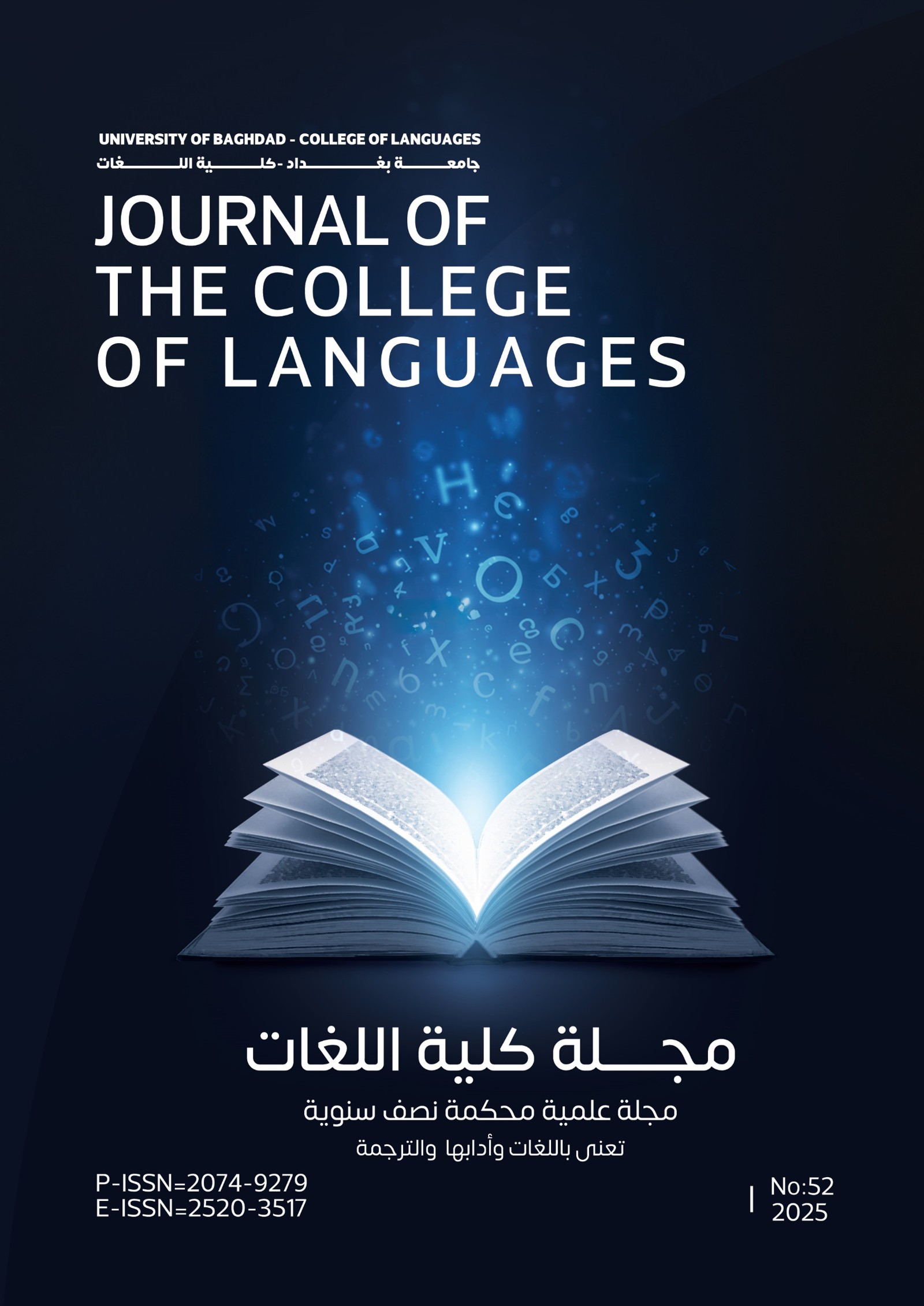The neology in the Iraqi dialect after the invasion of 2003 and the level of imaginative comprehension
La neología en el dialecto Iraqui tras la invasión de 2003 y el nivel de la comprensión imaginativa
DOI:
https://doi.org/10.36586/jcl.2.2024.0.49.0083Keywords:
Neología; neologismos; Dialecto iraquí; Teoría del Esquema básico de la referencia.Abstract
The article analyzes the neologisms that arose in the Iraqi dialect after the 2003 US-British invasion and the fall of Saddam Hussein's regime, according to the theory I advocate: "The Basic Outline of Reference," a developed theory of Arab legacy and cognitive theory, which came out in 1987 in America, so we have used the terminology of cognitive grammar. In this theory it is stated that the reference is the interaction between four components: perception, imagination, imaginative comprehension and the linguistic sign or symbolization (the neological word in this article), which are closely related, so that none of them can be lacking, because they constitute a holistic whole that belongs to a deeper level. Let us see how the speakers of Iraq, after the invasion of 2003, imagine the world according to their views, that is, their collective imaginative comprehension. This theory is going to be in the future the basis of a modern holistic linguistics which is very different from traditional linguistics.
Resumen
El articulo analiza los neologismos surgidos en el dialecto iraquí tras la invasión estadounidense-británica de 2003 y la caída del régimen de Saddam Hussein, Desde la perspectiva de “El esquema básico de la referencia”, teoría que aúna el legado de la tradición lingüística árabe y la teoría cognitiva desarrollada a partir de los primeros años 80 en EEUU, por ello que adoptemos la terminología de la gramática cognitiva. En esta teoría se considera que la referencia es la interacción entre cuatro componentes: la percepción, la imaginación, la comprensión imaginativa y el signo lingüístico o simbolización (la palabra neológica en este artículo), que están íntimamente relacionados, de manera que no puede faltar ninguno de ellos, porque constituyen un todo holístico que pertenece a otro nivel más profundo. Vamos a ver como los hablantes de Irak, tras la invasión de 2003, imaginan el mundo según sus puntos de vista, es decir, su comprensión imaginativa colectiva. Esta teoría pretende fundamentar las bases de una lingüística holística diferente de la tradicional lingüística.
Received on 2/6/2023
Accepted on 20/8/2023
Published on 2/1/2024
References
Anis, Ibrahim (1976): Dalalat al-alfaz, Cairo: al- Anlu al-misriyya, 3rd ed.
Cifuentes Honrubia, Jose Luis (1994): Cognitive grammar, critical foundations. Salamanca, Eudema.
Cifuentes Honrubia, Jose Luis (2oo6): "Semantic relations", at www. Liceus .com.
Corriente, F. (1977): Arabic-Spanish dictionary. Madrid, Hispano-Arab Institute of culture.
Corriente, F. (1980): Arabic grammar. Madrid, Spanish-Arab Institute of Culture.
Corriente, F. (1988): Spanish-Arabic dictionary. Madrid, Hispano-Arab Institute of culture.
Cortes, J. (translator) (2000): The Koran. Qum, Iran, Ansariyan.
Cortes, Julio (1996): Dictionary of modern cultured Arabic. Arabic-Spanish. Madrid, Gredos.
Cuenca, Maria Josep and Hilferty, Joseph (1999): Introduction to cognitive linguistics. Barcelona, Ariel.
Al-Gazali, Abu Hamid (died (d. AH 505, AD 1112), ms ( 1983): Miyar al-ilm fi fann al-mantiq. Beirut, Dar al-Andalus, 4rd ed.
Ḥassan, Tammam (1981): al-Usul. Dirasa ibistimulujiyya. Casablanca, Dar al-Taqafa.
Al-Haydari, Kamal (2004): Buhut fi ilm al-nafs al-falsafi. Critical edition of ‘Abdu Al-Allh Al-As‘ad. Qum-Iran, Dar kumayl.
Hussein Abid, Abeer (2008, 2011). The basic scheme of the reference. A schematic meaning model applied to Spanish and Arabic prepositions. Published in Germany, U.S.A. and U.K.: Editorial Academy Española; and University of Alicante. at www. The digital workshop. com.
Hussein Abid, Abeer (2009). Synonymy, polysemy and homonymy in the Arabic language. MEAH, (58), pp. 155-174.
Hussein Abid, Abeer (2013). The (autoantonymy) Al-ddad in languages, according to modern linguistics. JCL, (26), pp.51-66.
Ibn Faris Ahmad bn Zakariyya ms. (AH 1399, AD 1979): Miqyas al-luga. Vol. 6. Critical edition of ̒Abd Al-salam Muhammad Harun, Dar al-fikr.
Ibn Manur, Abu L-Fadil, Yamal Al-din Muhammad bn Makram, ms. (undated): Lisan al-‘arab, Beirut, Dar Sadir.
Ines Loyola, Maria, Jose Villa, Maria and Teresa Sánchez, Maria (2003): "The use of metaphors in the discourse of war", Sala de Prensa, 100, (62). Retrieved from www.saladeprensa.org, Vol. 2. Consultation date (7/22/2016).
Johnson, Mark (1991) The body in the mind. Spanish version of Horacio González Trejo, Madrid, Debate.
Al-Jazryi, Sufyan (04/14/2008): "Mustalahat wa mufradat sa ̔at fī al- Iraq ba ̔d al-ihtilal", Markaz al-NuR. Retrieved from www.alnoor.se. (3/28/2016).
Kamil Yawad, ̉Ayman (2003): "Mawrut lugawi, tasmyat wa kuna bi-alahja al- sa‘biyya", al-Mawrut, (70), Retrieved from www.iraqnla-iq.com. (6/22/2016).
Karim, Bayda̕ (01/16/2010): "Al-Sabab yagzun lahyatuna al-mahaliyya bi mufradat dajila", Markaz al-NuR. Retrieved from www.alnoor.se. Consultation date (3/28/2016).
Lakoff, George and Johnson, Mark (1980): Metaphors we live by. Chicago, the University of Chicago.
Lakoff, George and Johnson, Mark (1986): Metaphors of everyday life. Spanish version by Carmen Gonzalez Marin. Madrid: Chair.
Langacker, Ronald W. (1991) concept, image and symbol: the cognitive Basis of grammar. Berlin and New York, Mouton de Grayter.
Langacker, Ronald W. (1993) Foundations of cognitive grammar. Theoretical prerequisites, vol. I. California, Stanford University.
Ma ma‘na hadiqah wa hal̕ anta hadiqah? (January 2010). Retrieved from https://www.dorar-aliraq.net . Consultation date (3/28/2016).
Melara Navio, A.G. (1417 hijra, 1996 d.c.): The noble Koran and its translation into Spanish. Kingdom of Saudi Arabia, King Fahd Complex.
Al-Nayli, ‘Alim Sabyṭ (1999): al-Nizam al-qưrani. Muqaddima fī l-minhay al-lafza., Amman, Dar Usama.
Ortega Martín, Maria Pilar (2001): "Neology and the press: an effective pairing", Especulo: Magazine of Literary Studies, 18, Madrid. Retrieved from http://www . ucm. es/ info/ speculum/ number18/ neologism.html . Consultation date (8/22/2016).
Royal Spanish Academy (2001): Dictionary of the Spanish language, Spain, Broken paper, 22rd ed.
Russo, Adriana (2002): "Loanwords from English in economic jargon: Is it possible to avoid language over-indebtedness?" Proceedings of the I International Congress “Spanish, Language of Translation”. Retrieved from http://cvc.cervantes.es/lengua/esletra/pdf/01/015_russo . Consultation date 5/25/2016.
Sánchez, Aquilino (2001): Great dictionary of use of current Spanish, Madrid, SGEL.
Smith, C.C., Davies, G. A. and Hall, H. B. (1988): Langenscheidt modern Spanish-English and English-Spanish dictionary, Germany, Langenscheidt.
Al-Suyuṯi, Abu Bakar bn ‘Abd AL- Rahman Yalal Al-din (d. 911 AH) (undated): Tafsir du l-Yalalin. Baghdad, al-Dar al-‘Arabiyya.
Al-Suyuti, Abu Bakar bn ‘Abd AL- Rahman Yalal Al-din (undated): al-Muzhir fī ‘ulum al-uga wa ’anwa‘uha. vol.1. Critical edition of Muhammad Ahmad Yad al-Mawla and others, Dar al-Fikra.
Al- tabatba' i, Muhammed Hussayn: Al-mizan fi tafsir al Qur ̀an,. Recovered from
http://www.alseraj.net/a-k/quran/mizan/miz.htm , date of consultation (5-7-2012).
Vernet, Juan (1980): The Koran. Barcelona: Plaza and Juanes, 1rd ed.
Varo Varo, Carmen, Diaz Hormigo Mª Tadea and Paredes Duarte Mª Jesus, otro (2009): "Communication models and neological production and interpretation", Linguistic Research Magazine, 12, University of Murcia, pp. 185-216.
Al-Jarjani, ‘Abd al-Qahir (d.471 H. 1983 AD): ’Asrar al-balaga. Critical edition of H., Writer, Beirut, Dar al-Masira, 3rd ed.
Al-Jawahiri, Isma‘il bn Hamad (1987): Al-Sahah fī al-luga. Critical edition of Ahamad ‘Abd Algafur ‘Atar. Beirut, Dar Al-‘ilm l-Al-malayin, 4rd ed.
Yunis 'Ali, Muhammad Muhammad (1993):Wasf al luga al- 'arabiyya dalaliyan, fi daw' mafhum al-dalala al-markaziyya. Dirasa hawla al-ma'na wa zilal al-ma'na, Tripoli, University of Fath
Downloads
Published
Issue
Section
License
Copyright (c) 2024 Journal of the College of Languages (JCL)

This work is licensed under a Creative Commons Attribution 4.0 International License.








